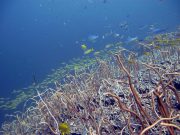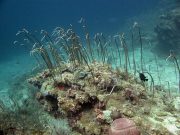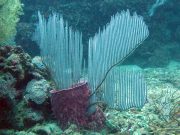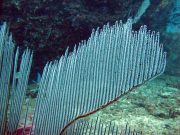Diving with Whip Corals
Lanta Marine Life | Ellisellidae
Whip corals grow everywhere in the southern Andaman Sea, including the klong (channel) which separates Lanta Yai from Lanta Noi. You can't miss these soft corals when diving from Koh Lanta.
Like the other soft corals, Ellisellidae is a family of whip corals which do not produce calcium carbonate skeletons. Instead, these corals have flexible skeletons made from a complex protein called gorgonin.
Each gorgonian polyp has eight tentacles which catch plankton and particulate matter passing in the currents. This family are recognised by their typical colony formation, which generally grow or branch upward.
2 species found on this page:
Sea Whip Coral
(Junceella fragilis)
Sea whip coral colonies grow vertically, up to 2m in length and are unbranched, with their upper third twisted or bent. The unbranched main axis is heavily calcified. The colony stem is white to brownish, densely covered with small polyps and containing zooxanthellae, which are responsible for the nutrition of the colony.
These corals are found in reef areas exposed to strong currents in deeper water or reef flats, reef slopes and flat coral rock.

Junceella fragilis @ Koh Haa
The colonies reproduce asexually; the upper end of a colony is shed and grows into a new whip-like coral. This results in very dense fields of these corals where thousands of colonies settle very close together.

Sea Whip Coral @ Koh Haa
The bivalve Pteria brevialata and gobies on the genus Bryaninops are found living symbiotically together with these corals. Brittle stars often climb up on to these gorgonians to use their exposed position to collect food from the current.
Lyre Sea Fan
(Ctenocella pectinata)

Ctenocella pectinata @ Koh Phi Phi
The Lyre Sea Fan, Harp Sea Fan or Red Whip Coral, has a distinctive comb-like shape, with many parallel branches growing vertically upward from the main stems.
The branches are of variable length and resemble the teeth of a comb.

Lyre Sea Fan with vertical, comb-like branches
The main stem is a deep red to brownish colour, with numerous while polyps on the vertical secondary branches. When the polyps are retracted, they form small lumps on the otherwise smooth stem.

Lyre Sea Fan Coral polyps are white
Lyre Sea Fan corals can grow more than 1 metre in height, with secondary branches reaching 60 - 70 cm in length.
This soft coral is found in areas with mild to medium current, between 10 m and 30 m, often close to other species of whip corals and sea fans.
Diving with Whip Corals around Koh Lanta
Scuba Diving & Snorkel Trips
If you'd love a chance to spot Whip Corals on one of our daily high season diving trips from Koh Lanta then send us an email to info@diveandrelax.com.
Join our high season speedboat dive trips to some of Thailand's best dive sites and enjoy small groups, short journey times, with a focus on great personal service, safety and fun.
Not yet a certified diver? Learn to Scuba Dive on Koh Lanta with the 3 day SSI Open Water Diver course.
Book online to save 10% on dive trips and scuba courses on Koh Lanta.
Find Out More
Indo-Pacific Marine Life Guides
- Allen, G., Steene, R., Humann, P., DeLoach, N. (2003) Reef Fish Identification, Tropical Pacific. Jacksonville, FL., USA: New World Publications, Inc., ISBN 1-878348-36-1.
- Humann, P., DeLoach, N., (2010) Reef Creature Identification, Tropical Pacific. Jacksonville, FL., USA: New World Publications Inc., ISBN 978-1-878348-44-9
- Debelius, H. (2013) Indian Ocean Reef Guide. Frankfurt, Germany: IKAN - Unterwasserarchiv, ISBN 978-3-939767-52-7.
- Debelius, H. (2004) Nudibranchs and Sea Snails, Indo-Pacific Field Guide. Frankfurt, Germany: IKAN - Unterwasserarchiv, ISBN 3-925919-51-1
- Erhardt, H., Knop, D. (2015) Corals Indo-Pacific Field Guide. Frankfurt, Germany: IKAN - Unterwasserarchiv, ISBN 3-925919-69-4.
- Veron J.E.N., Stafford-Smith M.G., Turak E. and DeVantier L.M. (2016). Corals of the World
